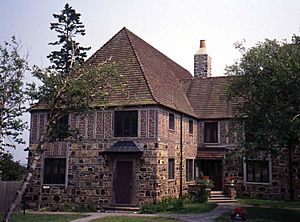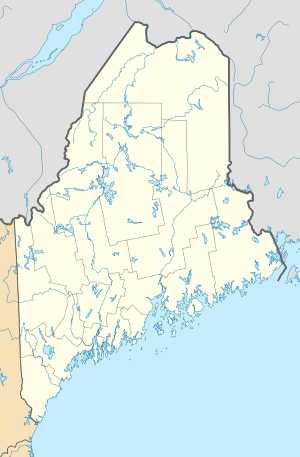Naval Security Group Activity, Winter Harbor facts for kids
Quick facts for kids Naval Security Group Activity, Winter Harbor |
|
|---|---|
| Part of Naval Security Group | |
| Winter Harbor, Maine | |

The "Rockefeller Building" at the former station
|
|
| Coordinates | 44°20′17″N 68°03′43″W / 44.338°N 68.062°W |
| Site information | |
| Owner | National Park Service |
| Controlled by | Acadia National Park |
| Condition | Standing |
| Site history | |
| Built | 1935 |
| In use | 1935–2002 |
| Garrison information | |
| Current commander |
James W. Guest |
| Garrison | Big Moose Island, Maine |
| Occupants | Branch Medical Clinic, Winter Harbor; Customer Service Desk, Winter Harbor Maine; Naval Satellite Operations Center Detachment Alfa; Naval Security Support Group Detachment Two; Defense Commissary Agency, Winter Harbor, Maine; Navy Exchange, Winter Harbor, Maine |
|
U.S. Naval Radio Station- Apartment Building and Power House
|
|
| Built | 1935 |
| Architect | Grosvenor Atterbury |
| Architectural style | Rustic Norman |
| NRHP reference No. | 13000533 |
| Added to NRHP | 5 July 2013 |
Naval Security Group Activity, Winter Harbor was a special radio station used by the United States Navy. It operated for many years, from 1935 until 2002. This station helped the Navy listen to radio signals and gather important information.
Contents
Why the Station Moved
In the early 1930s, there was an old Navy radio station called Otter Cliffs Radio Station. It was located on Mount Desert Island in Maine. This station was getting old and falling apart.
At the same time, John D. Rockefeller Jr. was helping to build Acadia National Park. He wanted to create a main road for the park that would go through the Otter Cliffs area.
The Navy agreed to move their radio station. They just needed to find a good new spot. It had to be on the coast and not too far from Otter Cliffs.
Finding a New Home
A perfect new spot was found on Big Moose Island. This island is at the tip of the Schoodic Peninsula. It's about 5 miles (8.0 km) across the water from Otter Cliffs.
So, the Navy, the Interior Department (which manages national parks), and Mr. Rockefeller all agreed. The radio station would move to Big Moose Island.
Special Buildings for the Station
Mr. Rockefeller wanted the new station's buildings to look nice. He wanted them to fit in with the beautiful park. So, he hired Grosvenor Atterbury, a famous architect from New York. Atterbury had also designed the park's gatehouses.
Atterbury designed a lovely residence hall for the Navy staff. It looked similar to Mr. Rockefeller's own home nearby. Skilled workers from all over the world helped build it. The residence hall and the power station next to it were very special. They were added to the National Register of Historic Places in 2013. This means they are important historical buildings.
When the Station Opened
On February 28, 1935, the new station officially opened. It was first called the U.S. Navy Radio and Direction Finding Station Winter Harbor. Chief Radioman Max Gunn was in charge, with 11 other people working there.
How the Station's Name Changed
Over the years, the station's name changed a few times:
- In 1944, it became the Supplementary Radio Station, U.S. Naval Radio Station Winter Harbor.
- In 1950, it was known as the U.S. Naval Radio Station (Receiver).
- Finally, on June 9, 1958, it got its last name: Naval Security Group Activity, Winter Harbor.
Closing Down the Station
In 2001, the station started to prepare for closing. The main goal was to give the land on the Schoodic Peninsula to the National Park Service.
Many parts of the station stopped operating:
- The last training course for system maintenance finished in July 2001.
- Large antennas, like the AN/FRD-10 Wullenweber and Classic Wizard, were taken down in August.
- The last church service was held at the Chapel on September 2, 2001.
- The Foc'sle Galley (the dining hall) served its last meal on September 28, 2001.
The station officially closed in 2002.
What Happened After the Closure
After the Navy station closed in 2002, the National Park Service (NPS) took over the land. They created the Schoodic Education and Research Center (SERC) there.
The SERC campus is now managed by a group called the Schoodic Institute. They work together with the NPS. It's one of 19 special research centers in national parks across the country.
This center is important for several reasons:
- It supports scientific research in Acadia National Park.
- It helps teachers learn new skills.
- It educates students who will become future protectors of our national parks.


